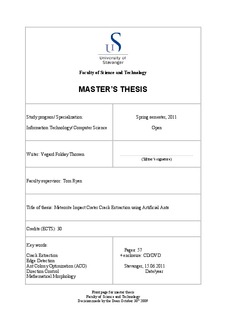| dc.contributor.author | Thorsen, Vegard Foldøy | |
| dc.date.accessioned | 2011-09-24T11:09:56Z | |
| dc.date.available | 2011-09-24T11:09:56Z | |
| dc.date.issued | 2011 | |
| dc.identifier.uri | http://hdl.handle.net/11250/181739 | |
| dc.description | Master's thesis in Computer science | en_US |
| dc.description.abstract | This Master’s thesis deals with extracting crack information from images of rocks taken from a meteorite
impact crater. By the use of artificial ants, and mathematical morphology, it becomes possible to detect
the edges in the images, or more specifically, the cracks outlines.
Ant Colony Optimization (ACO) is a method inspired by nature and the social behavior of some ant
species. ACO impersonates real ants and their foraging behavior where a chemical substance,
pheromone, is deposited on the ground in order to mark a favorable path between the colony and a food
source. This pheromone trail ensures that other members of the colony follows this exact same path.
When working with image edge detection it is possible to make use of this phenomenon. By exploiting a
similar mechanism and letting artificial ants traverse the images, they can detect the edges in the images
by mimicking the colony behavior of real ants. Furthermore is the original ACO method enriched by a
new direction control feature making the ants more adept at detecting edges belonging to a crack.
Experiments show the effectiveness of directed artificial ants in detecting edges in a digital image.
Mathematical Morphology (MM) is a technique that builds on mathematical set theory and the studies
of sets. The basic idea in mathematical morphology is to probe an image with a pre-defined shape, a
structuring element, drawing conclusions on how this shape fits or misses the shapes in the image. A
logical operation is performed between this structuring element and the underlying image, resulting in
different effects depending on the morphological operator being used. When working with image edge
detection it is possible to utilize this technique. By adjusting the structuring element to the features in
the images, the edges in the images can be detected using various morphological operators.
Experimental results demonstrates the usefulness of mathematical morphology in detecting edges in a
digital image.
Based on the obtained edge information, a novel approach utilizing statistics and shape properties are
developed in order to fill the gap between two corresponding edges. That way, the actual cracks
becomes highlighted. Experimental results demonstrates the practicability of the proposed approach in
extracting crack information from a digital image. | en_US |
| dc.language.iso | eng | en_US |
| dc.publisher | University of Stavanger, Norway | en_US |
| dc.relation.ispartofseries | Masteroppgave/UIS-TN-IDE/2011; | |
| dc.subject | informasjonsteknologi | en_US |
| dc.subject | datateknikk | en_US |
| dc.subject | crack extraction | en_US |
| dc.subject | edge detection | en_US |
| dc.subject | ant colony optimization | en_US |
| dc.subject | direction control | en_US |
| dc.subject | mathematical morphology | en_US |
| dc.title | Meteorite impact crater crack extraction using artificial ants | en_US |
| dc.type | Master thesis | en_US |
| dc.subject.nsi | VDP::Technology: 500::Information and communication technology: 550::Computer technology: 551 | en_US |
